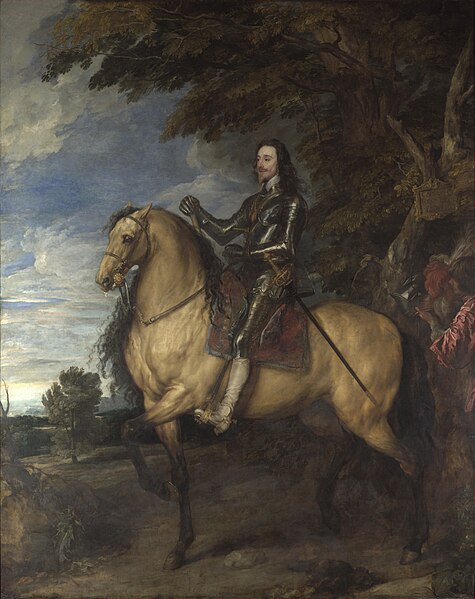
Title: Equestrian Portrait of Charles I
Artist: Anthony van Dyck
Date Painted: 1637-1638
Period: Baroque
Dimensions: 367 cm x 292.1 cm
Medium: Oil on canvas
Location: National Gallery, London
Summary of Equestrian Portrait of Charles I
The “Equestrian Portrait of Charles I” by Anthony van Dyck, created between 1637 and 1638, is one of the most iconic depictions of King Charles I. The painting, an oil on canvas measuring 367 x 292.1 cm, is housed at the National Gallery in London.
The portrait is a quintessential example of the Baroque style, characterized by its dramatic use of light, rich colors, and dynamic composition. Van Dyck, who was appointed as the Principal Painter in Ordinary to King Charles I and Queen Henrietta Maria, brought the influence of the Italian tradition, filtered through the Flemish master Rubens’ studio, to the English court. This work highlights van Dyck’s expertise in portraying royal grandeur and authority.
In the painting, Charles I is depicted as a sovereign leader and a Christian knight. He is mounted on a powerful, muscular horse, symbolizing control and dominance. The king is dressed in elaborate armor, holding a baton of command in his right hand and the horse’s reins in his left. This posture not only conveys his status as a military leader but also his proficiency as a horseman, despite health issues such as rickets during his childhood.
Behind Charles is an equerry holding a plumed helmet, suggesting readiness for a tournament or battle. Above them, a Latin inscription on a tablet tied to an oak tree reads “CAROLUS REX MAGNAE BRITANIAE,” emphasizing his rule over Great Britain, including England, Scotland, and Ireland. The background features a serene, wooded landscape painted in muted colors, enhancing the calm and controlled atmosphere of the scene.
Van Dyck intended to present Charles not only as a monarch but as a benevolent ruler and a chivalric knight. The gold chain around his neck signifies his membership in the prestigious Order of the Garter, an order of chivalry founded by King Edward III. This chain also symbolizes his connection to Saint George, the patron saint of the order, whose image is depicted on a locket that the king wears.
The portrait draws inspiration from earlier works, notably Titian’s “Equestrian Portrait of Charles V,” reflecting a tradition of depicting rulers as commanding and noble figures on horseback. This portrayal aims to legitimize and glorify Charles I’s reign during a period marked by political tension and eventual conflict.
In summary, the “Equestrian Portrait of Charles I” by Anthony van Dyck is a significant Baroque painting that combines regal authority, military prowess, and Christian virtue, encapsulating the multifaceted image of King Charles I before the turmoil of the English Civil Wars.